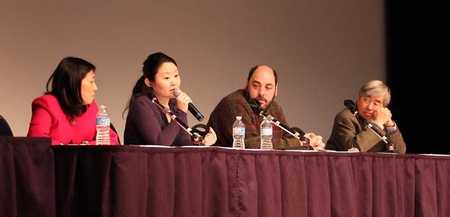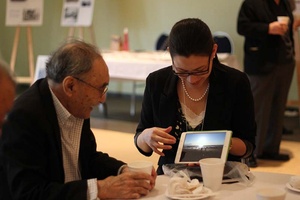At the first Japanese Canadian Heritage Committee conference I attended, back in 2010, I was invited to come on the night before the main event and give a warmup with some historical background. At the Keisho conference last year, I was asked to attend and then speak about my reflections at the end. This time, I appeared on both ends, as kickoff speaker the first morning and then as assessor. I am very glad to take on the task of giving an honest appraisal of my personal reactions to the conference and to do some thinking about it.

Prof. Greg Robinson (second from the right) at the final day's panel of the Keisho conference. The speaker is Elizabeth Fujita, Coordinator for the Sedai Project at the Japanese Canadian Cultural Centre (Courtesy of the Japanese Canadian Cultural Centre)
First, I can say that for me the conference was a very satisfying experience. Over the course of the weekend I met and spoke to a number of new people (I ran through the stock of meishi I had brought), as well as people I had met at previous conferences. I listened to the storytellers and learned lots of things I did not know. In fact, I was so energized by the conference that even after the dinner hour the first night, I hung around and chatted with some of the remaining people until they left, and then went off with a few folks for a drink (non alcoholic in my case, as I was still on duty). By the time I went to my room to try and put my thoughts about the conference in order for the wrapup, it was late, but I still felt the rush of excitement lingering.
Let me summarize my impressions of the conference for those who were absent, and then even more importantly, to figure out what it means. The weekend’s activities started with some fine opening remarks by James Heron, Executive Director of the Japanese Canadian Cultural Centre, and Mike Oikawa, a former Executive Director. James spoke in Japanese as well as English. Apart from such fluency making me envious, as my own comand of Japanese is minimal, I thought it was a fine note of recognition of the New Nikkei (shin Issei) and their experience in postwar life. Even though immigration from Japan to Canada remained heavily restricted until 1967, the end year of this conference, some Japanese did make their way there in the postwar years, including those who came as war brides.

Former Coordinator for the Sedai Project, Lisa Uyeda (yonsei) utilizing technology to connect with an attendee. (Courtesy of the Japanese Canadian Cultural Centre)
I was then invited to give my lecture. I began by stating that the postwar experience of Japanee Canadians was very much a “black hole” in terms of the historical literature, and that for me the conference was a valuable opportunity to connect with storytellers to fill up the holes in our general knowledge. After noting some parallels with the postwar experience of Japanese Americans (itself an understudied topic) which I had treated at length in my recent book AFTER CAMP, I discussed some of my own research on postwar Japanese Canadians, including their resettlement, family life, jobs and housing, sports, and civil rights.
I explained what I knew from reading documentary sources, and what kinds of information I needed from individuals to supplement it. My conclusion was that the conference was created to find people’s stories, since these remain vital for family and community members and for the larger Canadian society.
My listeners were very attentive, though I learned later that some people were unable to hear what I said, and individuals came up to me later to give me useful information on different points. For instance, I had spoken of the populartiy of Nisei sports, including intercity baseball and bowling leagues. I learned later that Nisei baseball teams from Toronto travelled as far as Chicago in the postwar years to face off in tournaments against local squads.
I was also asked why bowling was such a popular Nisei sport. My guess was that it was an inside game that could be played year-round—not a trivial detail in wintry Canada—and that it was good exercise. It also gave Nisei, who were not all that tall or heavy on the average, a sport at which they could play on a level with others. (Actually, I just recently published an article in “The Great Unknown”, my regular column in Nichi Bei Weekly, about how in the late 1940s the Japanese American Citizens League sucessfully challenged the whites-only policy of the American Bowling Congress by joining forces with labor unions and African American groups in the National Committee for Fair Play in Bowling, a coalition headed by the young mayor of Minneapolis, Hubert Humphrey.)
After my speech came the first of the three rounds of storytelling that dominated the day’s activities. Since the storytelling sessions were identical in format, I will speak about them as a whole. What I think they demonstrate is the tremendous geographical diversity of the postwar experience. Some people stayed in New Denver, one of the “ghost towns” of the Slocan Valley where they had been moved during the war, and received exemptions from expulsion in order to care for sick family.
Some people went back to the West Coast once it reopened in mid-1949 (one of the storytellers told the poignant story of her father taking the family back to the West Coast fishing village of Steveston once it opened up, only to perish a few months later in a boating accident). Others went east, to Winnipeg, Toronto, Montreal, Hamilton, or more rural areas. Others went to Japan, and many of them slowly drifted back to Canada in the following years.
I was struck from the stories by how many of the people who scattered across Canada chose to move to places because they had relatives already there. Once arrived, they took whatever jobs they could find—such as agricultural laborers, gas station attendants, and domestics—and worked punishing hours for low pay.
The housing shortages were astounding: one family rented space within a three bedroom bungalow, where the owner lived in one bedroom, the owner’s kids in another, another family in the third bedroom, the speaker and father in the living room, and yet another family downstairs in the basement.
One Nisei told us of moving to Toronto. Eventually, he missed eating Japanese food so much that he and a buddy found a Nikkei family in West Toronto willing to take them in, at an affordable rate: room and board for him and his buddy at $13/week. The catch was that the room contained only one double bed (while this slightly risqué-sounding detail gave rise to some giggles from listeners, actually it was not uncommon in older times for straight guys to be roommates or even bedmates—in the recent Stephen Spielberg film Lincoln we see the President’s two secretaries, Hay and Nicolay, sharing a bed at the White House).
To my surprise, even under direct questioning from facilitators, storytellers were mostly unable to recall direct prejudice against them—although one Nisei who relocated to Montreal in 1943 told me of a party of Japanese Canadians being refused service at a Chinese restaurant whose owners were hostile to Japan.
The humiliations were there, though, and came in different forms. Frank Moritsugu, a Nisei veteran, spoke of being discharged from the Canadian army in 1946 and returning to live with his family. Soon after, he was visited by an RCMP agent who gave him his old “alien identity card” and ordered him to renew the photo. Even after he had fought in defense of his country against Japan, Frank was still treated officially like an enemy alien!
Another Nisei spoke of working as an engineer at Averill Aerospace, which made the Avro Arrow, a Canadian military interceptor aircraft. When the Diefenbaker government cancelled the project in1958, he was laid off with other engineers. Unlike his colleagues, who could take better jobs in the United States, working on the 747 in Seattle or at NASA in Florida, he was restricted from entering the USA by the tiny “Japanese” immigration quota, which meant that it was too difficult to get even a temporary visa.
Another Nisei told me that he was accepted with a scholarship by University of British Columbia in the late 1940s, but when the admissions personnel realized he was Japanese, and was restricted from the West Coast, rather than help get him an exemption or make alternate arrangements they withdrew the scholarship.
The storytellers also bravely revealed their internalized shame. In a poignant moment, one speaker noted that while she was welcomed by non-Japanese girls in Lethbridge, Alberta, where she settled during the war years, she did wish that she was blond and had long hair like her friends.

Storyteller Dr. Arnold Arai giving his feedback at the closing session, an Open Panel Q&A for all attendees, volunteers, and planning committee members. Dr Arai gave an impassioned speech about the importance he sees in the efforts of the Conference, the Archives, in documenting a past that is slowly disappearing as we are losing our elders, and how vital it is for members of his generation to speak up about their experiences. (Courtesy of the Japanese Canadian Cultural Centre)
© 2013 Greg Robinson





